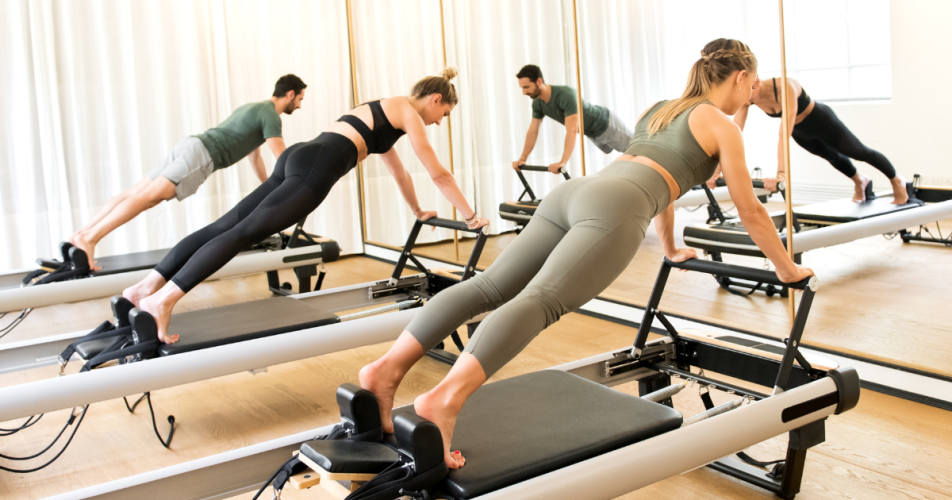BLOG

Date
Years ago, Pilates was a very common form of exercise. Most people knew about Pilates, and how often they should take Pilates classes. But as with most things in life, new fads and innovations temporarily pushed Pilates out of the limelight. Over time, this beneficial workout was somewhat forgotten as buzzwords like “HIIT”, and “CrossFit” took center stage. These newer forms of exercise are great for many people. But Pilates is a gentle and effective exercise that most people can engage in, regardless of fitness level. It may also carry a lower risk of injuries.
Thankfully, fitness gurus and regular people started remembering just how beneficial Pilates can be. Sometimes the most effective workouts are those that have produced tried-and-proven results for years. Pilates may be just the ticket if you’d like to strengthen your core, increase your flexibility, and develop more defined muscles. But before you begin, you may wonder, “How often should you do Pilates?” This guide aims to answer that question and help you get the best benefits from your workouts.
So, what is Pilates anyway, and why is it rising so quickly in popularity? Early in the 20th century, Joseph Pilates developed this unique exercise technique. That means people have relied on this type of workout to improve their body composition for almost 100 years! Though Pilates was primarily developed to help injured dancers recover, its modern-day applications are much broader.
Many of the movements in Pilates are small yet highly effective. These small movements can yield dramatic results when performed with control and concentration. Here are a few of the movement principles guiding the Pilates method:
Pilates is a form of strength training, but it looks much different from other popular strength training exercises. While many similar exercises focus on building muscle size, Pilates offers a different outcome. It’s known primarily for improving muscle tone and endurance. Rather than contributing to a bulky appearance, Pilates is known for contributing to a leaner, longer physique.
Before diving deeper into how often you should do Pilates for the best results, it’s important to realize that everybody is different. Not everyone who does Pilates will experience the same outcome. But if you want to make noticeable changes to your body, you must determine how many Pilates workouts are right for you.
Many people wonder, “How often should you do Pilates?” Though this may seem like a copout, the answer often depends on everyone’s specific goals. For example, if your primary fitness goal is to increase muscle size and definition, but your secondary fitness goal is to improve your flexibility. In that case, you may want to do weight-lifting sessions three times per week and Pilates twice per week.
But if your main goal is improving core strength while increasing flexibility and building overall muscle endurance, Pilates should be your go-to exercise. So, how many times a week should you do Pilates? To reap the best benefits, you’ll want to do it 3-5 times per week. However, you may not want to do it every day of the week because your muscles need time to recover.
People are often surprised to discover how many benefits they can experience by doing Pilates workouts regularly. And, since Pilates has been around so long, there are several studies that provide evidence for its efficacy. Here are some of the impressive benefits Pilates may be able to offer you:
This is just a small sampling of the many proven and well-studied benefits Pilates can offer. But to achieve these results, you can’t just casually engage in one or two Pilates sessions. Instead, you should make Pilates a consistent part of your weekly workout routine for optimal results.
Once you get into a steady workout habit, how long does it take to see results from Pilates? While individual results may vary, most people can see noticeable body changes within just three weeks. However, those who do Pilates less often may take up to eight weeks to see noticeable results in their bodies.
However, Pilates changes more than just the body. It can also boost mental health and reduce feelings of depression and anxiety. Many people participate in Pilates workouts primarily for the mental health benefits they offer. However, if you feel down occasionally or frequently, you may be surprised to discover how much better you feel after a Pilates workout.
To increase your likelihood of sticking to a Pilates routine, join a group exercise program. There are many benefits to working out with others. When you’re in a group setting, you’re more likely to work out harder than you would if you were by yourself. Additionally, working out with friends can help you develop positive mental associations with exercise.
If you’re still wondering, “How often should you do Pilates?” the answer is quite simple. Do it as often as it takes to meet your physical and mental fitness goals. You may want to start out slow, then build up to more frequent workouts once your body becomes more accustomed to them. It’s normal to experience some soreness when you begin, but it should alleviate over time as your body becomes stronger.
If you’re ready to start reaping the benefits of this incredible form of exercise, we invite you to join us here at sculp’d. We offer guided, in-person Pilates classes in Alexandria, VA. Call us at 703-337-3341 to learn more about our classes or to sign up. We can’t wait to meet you and guide you on your journey to a leaner, longer, and stronger body!
@sculpd